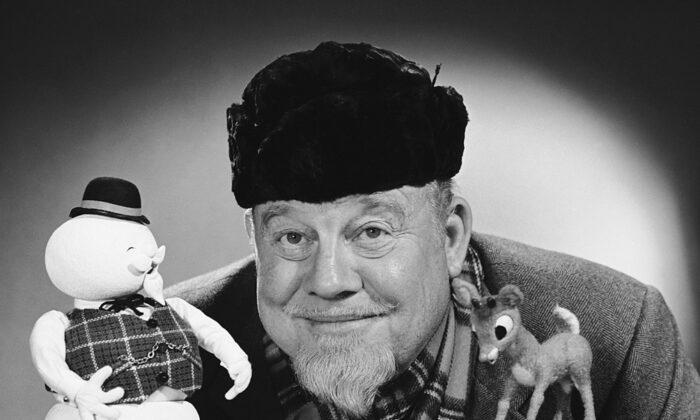If nothing else, younger readers will at least know the distinctive, slightly scratchy voice of the great Burl Ives from the perennial Christmas songs “Holly Jolly Christmas” and “Rudolph the Red-Nosed Reindeer.” These songs are both from the beloved NBC stop-motion-animated TV special of the latter title (1964), still aired annually, in which Ives performed the voice of the banjo-playing snowman-host and narrator.
Older readers will know Burl Ives for much more, be it his contributions to radio, Broadway, folk music, country music, Hollywood films, or television. Many of us saw him pop up in these venues for decades, but perhaps we never connected the dots. To see all that Ives did, laid out together in one list, is to realize just what a head-spinning whirlwind of a career he enjoyed.
The thing that all his appearances had in common, though, was his fundamentally endearing, teddy-bear personality. He was the sparkling-eyed, down-home uncle anyone might wish for, if they didn’t have one.

An American Minstrel
Ives was born in 1909 in rural Illinois, one of seven children, to a farming family. His pipe-smoking grandmother taught him all manner of English, Scottish, and Irish folk songs, most of which were ballads that told a story. One day, he was singing with her in the garden the old folk song “Barbara Allen,” when he happened to be overheard by his uncle. His uncle invited him to sing it at a local veterans’ reunion meeting, where his singing was much appreciated, so Burl took up the banjo and kept on singing. He tried to go to college and even joined the football team, but he had no interest in academic studies and dropped out in his junior year, destined to become a quintessential American minstrel.
Ives’s fortunes were not immediately found in film but back in New York on several radio shows. His own show, called “The Wayfaring Stranger,” rode the early wave of interest in folk music that made famous such names as Pete Seeger, Woody Guthrie, and Will Geer (later to star as Grandpa in the 1970s hit TV show “The Waltons”). In fact, Ives was a member of a folk group called The Almanac Singers with those singers.
Actor and Anti-Activist
During the 1940s and 50s, his radio and music recording work progressed steadily, but it was increasingly supplemented by acting roles both on stage and in film. The first of over 20 films that Ives made in the next four decades was the little-known 1946 “Smoky,” from a Will James novel.His Broadway credits included “Paint Your Wagon,” “Showboat,” and famously, the role of Big Daddy in the critically acclaimed Tennessee Williams play “Cat on a Hot Tin Roof,” both on stage (1955) and in the film version (1958). Ives also proved a dauntingly serious film actor in “The Big Country” (1958), for which he won an Academy Award for Best Supporting Actor.

He made a convincing argument to them that he was not by any means a communist sympathizer and that America’s treasury of great folk songs, at least the ones he sang, were in fact very patriotic. He went on to “name names,” implicating as communists a few of the people in the folk movement (none remembered today). Ives’s cooperation satisfied the committee and exonerated him for the remainder of his career, but alienated him from many of the folk performers who did not appreciate his testimony.

Burl Ives was often seen smoking a cigar or a pipe, and it followed that in 1994, at age 85, he was diagnosed with oral cancer. The disease claimed his life in 1995, just before his 86th birthday. Now, more than 25 years later, his legacy and contributions to American music and culture remain strong and continue to endear themselves to new generations.






